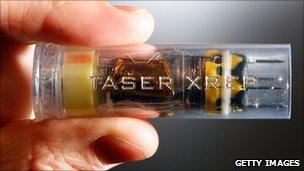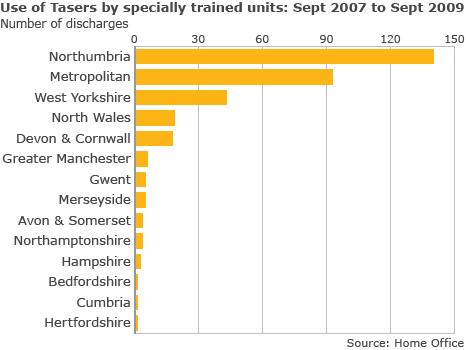Q&A: Tasers
- Published

The XRep is fired from a 12-gauge shotgun
The company which supplied the Tasers - electric stun weapons - used during the six-hour stand-off with gunman Raoul Moat has had its licence revoked.
It comes after the Independent Police Complaints Commission (IPCC) confirmed at the opening of the inquest into Moat's death that two police officers fired Tasers.
Q: What has the firm lost its licence for?
The Home Office said Pro-Tect Systems breached its licence by supplying X12Tasers and Taser XRep ammunition direct to Northumbria Police and another police force "contrary to their authority".
Home Secretary Theresa May said the company had only been permitted to supply the Tasers to the Home Office's science and development branch for testing.
The firm also "breached rules governing the secure transport of the devices and ammunition", the Home Office said.
Q: Have the police now lost the ability to get any Tasers?
The Home Office said Pro-Tect Systems, which is the only supplier of Tasers in the UK, has been granted a short-term authority to "dispose lawfully" of its remaining stock.
It said it would work with the Association of Chief Police Officers (Acpo) to ensure police forces got the approved Tasers they needed.
Q: What type of Taser was fired at Moat?
The IPCC said the police officers in question used the latest Taser weapon designed by US company Taser International, the Taser XRep.
This is a cartridge that can be fired from any 12-gauge pump-action shotgun, and contains six electrodes that stun the victim for 20 seconds on impact.
It differs from previous Taser guns in that it is a wireless system and has a range of 100ft (30m) rather than 21ft (6.5m).
By contrast, earlier Taser guns resemble pistols, and use compressed air to fire two darts that trail electric cables back to the handset.
Q: Is the XRep in widespread use?
No, because it is still undergoing testing.
The Home Office confirmed that while it has not yet been approved for use by forces in England and Wales, it was still legally used in the stand-off with Moat.
"It is currently subject to testing by the HOSDB (Home Office Scientific Development Branch)," said a Home Office spokesman.
"However, legally, police forces have discretion to use any equipment they see fit as long as the use of force is lawful, reasonable and proportionate."
Q: When were Tasers first introduced to police in the UK?
They were introduced in England and Wales in 2003, when a 12-month trial saw specialist firearms officers in five police forces carrying them.
The officers were only allowed to use them in circumstances where they were authorised to draw weapons. During the trial the weapons were fired 13 times.
In 2008 Tasers were rolled out across England and Wales, and were no longer limited to specialist firearms officers.
Some forces were criticised for allowing officers to use Tasers after just two days' training.
There are currently two pistol-shaped Tasers approved for use by the Home Office - the X26 and M26 models.
Q: How often have Tasers been used since then?
Home Office figures show , externalthat between 22 April 2004 and 30 September 2009, Tasers were used 6,296 times in England and Wales.
The Metropolitan Police, which covers the Greater London area, used Tasers more than any other force - 1,006 times. But not far behind them was Northumbria with 884 incidents.
Officers were originally only allowed to use them when confronted by an armed attacker, but in July 2007 those powers were extended to include incidents of serious violence or threat.
The first force to use Tasers in Scotland was Strathclyde, which began a pilot project in September 2005.
The Police Service of Northern Ireland began using the weapon in August 2008.
Q: How safe are Tasers?
There is some controversy surrounding the use of the weapons.
Human rights group Amnesty International says they have been linked to dozens of deaths in the United States.
It warns they cause "intolerable pain" and may exacerbate the risk of heart failure in people under the influence of drugs or with some health problems.
In 2006 Brian Loan, 47, died several days after being shot by a Taser in County Durham.
A coroner recorded a verdict of death by natural causes, attributing his death to heart disease, but his sister, Barbara Hodgson, refused to accept the Taser was not to blame and said future cases would prove her right.
In October last year Taser International warned officers to avoid aiming at the chest area., external It said that by avoiding the chest they can avoid the controversy of whether the device caused cardiac attacks.
But Tasers have become standard police equipment in the UK and are regarded as a less dangerous alternative to guns.
The Defence Scientific Advisory Council's sub-committee on the Medical Implications of Less Lethal Weapons (Domill), an independent group of medical experts, has issued four statements on the medical implications of the use of the Taser.
Its view is that the risk of death from primary injury with a Taser is low and certainly much lower than that from conventional firearms.
Q: What checks are there on the use of Tasers?
During the first pilot of Tasers in 2003, all incidents in which they were discharged were referred to the Independent Police Complaints Commission (IPCC), which investigates police complaints.
Now, only if there is a complaint, death or serious injury are incidents referred.
The IPCC says Tasers are a useful alternative to lethal weapons where used appropriately.
The Home Office says it monitors and produces a detailed report every time a Taser is deployed.
This information is collated every three months and assessed by the medical panel, Domill.

- Published13 July 2010
- Published10 July 2010